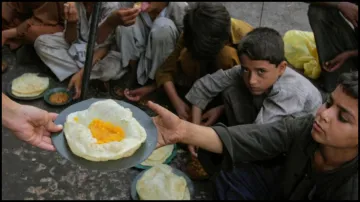Why did cash-strapped Pakistan require another IMF loan and what it entails? EXPLAINED
Pakistan's crumbling economy has been beset by decades of financial mismanagement and poor governance, as citizens are struggling to meet their basic needs. This is Pakistan's 25th loan from the IMF and it has become the lender's fifth-largest debtor.

Islamabad: Pakistan, which has experienced massive inflation, high levels of debt and economic losses, has received a much-needed relief as the International Monetary Fund (IMF) approved a $7 billion loan on Wednesday. Pakistan will face the first $1 billion immediately while the rest of the loan will be paid out over the next three years.
The IMF board met on Wednesday in Washington to give a nod to the staff-level agreement with Pakistan after Islamabad promised to overhaul its agriculture income tax, transfer some fiscal responsibilities to provinces, and agree to limit subsidies. The Prime Minister’s Office confirmed the Executive Board of the IMF approved the Extended Fund Facility (EFF) totalling $7 billion, which will last for 37 months.
The loan is aimed at strengthening Pakistan's fiscal and monetary policy while also bolstering reforms to broaden the tax base, improve the management of state-owned enterprises, strengthen competition, secure a level-playing field for investment and scale up social protection through increased generosity and coverage in a major welfare programme, IMF said.
Why did Pakistan need another IMF loan?
Pakistan has been long plagued by financial mismanagement and poor governance. It has become the fifth-largest debtor of the IMF and has taken more than 20 loans since 1958. Pakistani citizens continue to bore the brunt of one of the worst financial crises in the country, struggling to even meet their basic needs.
Last year, Pakistan's economic growth declined to 2.4 per cent, lower than the population growth of 2.6 per cent due to a large budget deficit and an increasing debt burden. Almost all of its foreign reserves dried up and its tax collection, state-owned enterprises and energy sector remained weak. All these factors cumulatively brought Pakistan to a near-default in 2023, which was averted due to an emergency arrangement with the IMF and assistance from China, Saudi Arabia and the United Arab Emirates.
Pakistan struggled to pay the 2019 EFF granted by the IMF due to the effects of the COVID-19 pandemic, Russia's war in Ukraine and a series of disasters, leading the global money lender to stop the disbursement of $2.5 billion due to ineffective steps taken on energy rates and tax impositions. As a result, Pakistan's economic crisis deepened, with inflation going as high as 38 per cent
Food inflation, in particular, has surged to 48 per cent, a level not witnessed since 2016. The devaluation of the Pakistani currency made it difficult to avail even basic facilities like food, shelter, healthcare, and education for the common man in the country. A combination of tax and gas tariff hikes and a steep fall in the rupee currency had also pushed inflation up to nearly 30 per cent.
What does the package entail?
IMF's Extended Fund Facility is aimed at providing financial assistance to countries facing serious medium-term balance of payments problems because of structural weaknesses that require time to address. It is typically approved for periods of 3 years but may be approved for periods as long as 4 years to implement deep and sustained structural reforms.
The new bailout package targets achieving macroeconomic stability by consolidating public finances, rebuilding the foreign exchange reserves, reducing fiscal risks from state-owned enterprises, and improving the business environment to encourage growth led by the private sector. The IMF said the new programme will require "sound policies and reforms" to strengthen macroeconomic stability and address structural challenges in Pakistan.
Pakistan's Finance Minister Muhammad Aurangzeb warned that the country would face "transitional pain" after the IMF loan. "There will be transitional pain, but if we are to make it the last program, then we have to carry out structural reforms," said Aurangzeb while emphasising the need for carrying out reforms.
What did Pakistan do to secure IMF loan?
The Pakistani government, having no other option but to ask for another IMF bailout, has adopted some unpopular measures as part of the conditions to secure the package, such as raising agricultural income tax from 12-15 per cent to 45 per cent next year, despite protests in recent months by retailers and some opposition parties.
The federal government will not be entitled to have any new economic zones and will end the tax incentives of the existing zones by 2035. All four provincial governments will align their agriculture income tax rates to the federal personal and corporate income tax rates by amending their laws by October 30. All the provincial governments will also refrain from giving further subsidies on electricity and gas.
The cash-strapped country has also received "significant financing assurances" from China, Saudi Arabia and the UAE linked to the IMF loan after agreeing to roll over Pakistan's $12 billion debt for one year. It also took the most expensive loan in Pakistan's history -- USD 600 million -- to win a board meeting date from the IMF. Pakistan imposed a record Rs 1.8 trillion in new taxes and hiked electricity rates by up to 51 per cent to secure the package.
ALSO READ | Cash-strapped Pakistan gets $7 billion loan from IMF, Finance Minister says will face 'transitional pain'